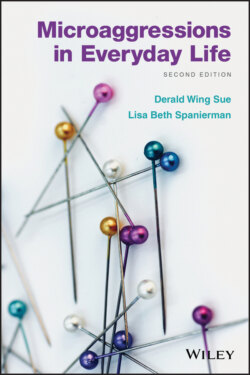Читать книгу Microaggressions in Everyday Life - Derald Wing Sue - Страница 15
Sexual‐Orientation Microaggressions
ОглавлениеHeterosexism, like racism and sexism, can operate in overt and subtle ways (Nadal, Whitman, et al., 2016). Early conceptualizations of homophobia referred to fear of and aversion to gay individuals. Noting limitations of the term, Herek (1990, 2000, 2004) proposed a more nuanced terminology to better capture individual, institutional, and cultural forms of oppression directed at lesbian, gay, and bisexual people. He coined “sexual prejudice” broadly, as negative attitudes and hostility toward sexual minorities. He further defined “sexual stigma” as referring to society's negative stance toward anything not heterosexual and “heterosexism” as the ideological system that justifies denigrating sexual minority identity, behavior, and communities. Subsequently, researchers have differentiated old‐fashioned and modern forms of heterosexism (Cowan, Heiple, Marquez, Katchadourian, & McNevin, 2005; Eldridge & Johnson, 2011; Morrison & Morrison, 2003). “Old‐fashioned heterosexism” refers to overt expressions of antigay and antilesbian attitudes and behaviors, taking form in hate speech and hate crimes, for example. Similar to modern racism and sexism, and germane to our discussion of microaggressions, “modern heterosexism” refers to subtle expressions of bias toward sexual minorities.
Nadal (2013) defined sexual‐orientation microaggressions as brief, everyday insults and invalidations that communicate heterosexist and homophobic slights toward gay, lesbian, bisexual, and queer individuals. These microaggressions occur across social and physical locations—nobody is immune. Common examples involve comments in the classroom or schoolyard. For instance, a gay adolescent was frequently made to feel uncomfortable when fellow classmates described silly or stupid behavior by saying “That's gay.” The hidden message is that being gay is something negative or deviant. In another example, during a conversation among a group of male fraternity brothers, one guy said, “I love you man,” followed by “No homo” as a way to reassert his heterosexual masculinity. The hidden message is that it is not okay to be gay.
Other examples often are evident in health care settings. In a mental health counseling context, for example, a lesbian client reluctantly disclosed her sexual orientation to a straight male therapist stating that she was “into women.” The therapist indicated he was not shocked by this disclosure because he once had a client who was “into dogs.” The microaggression involves the implication that being a lesbian is abnormal and akin to bestiality.
